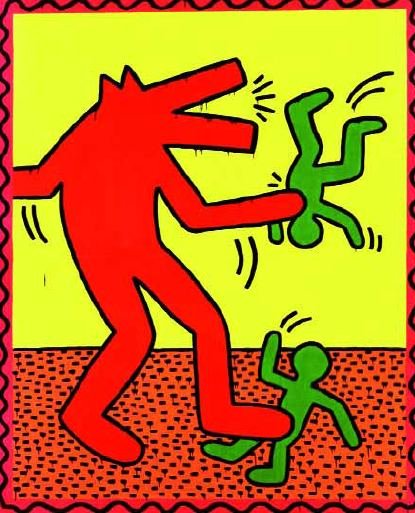Keith Haring
dal 21/2/2008 al 28/6/2008
Segnalato da
21/2/2008
Keith Haring
Museum of Contemporary Art - MAC, Lyon
The retrospective will be set out in a deliberately nonchronological sequence, showcasing paintings, sculptures, drawings, photos, videos. The artist's short career, spanning the years from 1980 to 1990, is viewed as a whole. A big ensemble of more than a hundred drawings reveals the diversity of Haring's graphic world and the directness of his style, expressing sincerity and passion by means of a continuous and consummate line. Curated by Gianni Mercurio.

curated by Gianni Mercurio
This exceptional exhibition has been entrusted
to the Italian curator Gianni Mercurio and is being organised
in close collaboration with the Keith Haring
Foundation in New York. It presents an unprecedented
ensemble of works from the most important American
and European collections, both public and private.
The retrospective will be set out in a deliberately nonchronological
sequence. The artist's short career,
spanning the years from 1980 to 1990, is viewed as
a whole. Like Keith Haring in his own work, filling the
canvas, putting his art in the most unexpected places,
covering even objects and bodies, the exhibition will
take over the museum, taking possession of the spaces
in order to immerse visitors in the colourful, dynamic
and teeming world of this artist. It comprehensively
deploys Haring's practice, including its essential paintings
on tarpaulin and its monumental paintings (including the
canvas made in 1987 for the Casino at Knokke-le-
Zoute).
Most of all, though, it allows visitors to discover the
extraordinary diversity of the supports and media
that Haring used so freely - vinyl paint, acrylic
enamel paint, chalk, ink, felt pen, on canvas, metal,
paper, wood and even the human body (including
that of Grace Jones in 1985).
A big ensemble of more than a hundred drawings
reveals the diversity of Haring's graphic world and the
directness of his style, expressing sincerity and passion
by means of a continuous and consummate line. The
influence of classical art is manifest here, as is that of
African, Asian and South American cultures.
The exhibition conveys Haring's open, cultivated mind,
as manifested in his formally diverse works nourished by
his encounters, readings and the places discovered on his
travels. Whether on relatively classical supports (canvas,
paper, metal, etc.) or more unexpected ones, such as the
BMW, also presented in the exhibition (“Original Keith
Haring Object Z1”, 1990), beyond the apparent gaiety
of the images we are aware of Haring's interest in the big
issues of the day: AIDS, drugs, the power of money, etc.
For Haring worked at the heart of everyday life.
There are, too, moments of questioning and revolt: the
apocalyptic visions and monstrous creatures in his work
transcribe the scourges of the modern world, such as the
nuclear threat and the AIDS virus, and heighten the
intensity of his very personal iconography.
Never before seen by the general public, the series of
paintings on fences are highlight of the show, as are the
“Subway Drawings” (some only as photographs, the
originals having sadly been destroyed). This exceptional
ensemble, made on a construction site fence in New
York, shows the artist's powerful need to occupy urban
space and to break free of the cultural milieu and the art
market. In the same vein, and specially reinstalled for
the exhibition, his astonishing “Pop Shop Tokyo” (1985)
illustrates his desire to make art accessible to all and surrounds
us from floor to ceiling with the incredible shop
where he could make his work directly available to the
general public.
To complete this teeming ensemble - to which must be
added the monumental sculptures - projections and an
exceptional series of photographs shed light on the
production of Haring's work.
A video entitled “Haring ALL OVER” closes the exhibition.
The film, shown on several screens, presents tributes to the
artist as well as interviews never shown before. These
images take visitors to New York, Chicago,
Philadelphia, Paris, Düsseldorf, Berlin, Antwerp,
Knokke-le-Zoute and Monaco, where Haring made interventions
in public space. The itinerary ends in Pisa,
where the artist made his last mural painting,
“Tuttomondo”, only a few months before his death.
Faithful to the spirit of Keith Haring, who worked to
make art accessible to all, the sequence continues outside
the museum with an exceptional presentation at
the Treasure’s room of the museum of Fourvière, of the
big altarpiece he made in 1990.
Musee d'Art Contemporaine
81 quai Charles de Gaulle. Lyon
Open from Wednesday to Friday, from 12 am to 7 pm
Saturday and Sunday from 10 am to 7 pm.
Full: 8 - Reduced: 6 - Family: 10 (2 adults + 2 children or more)



